Abstract
Benzene, an important component in gasoline, is a widely distributed environmental contaminant that has been linked to known health effects in animals and humans, including leukemia. In Mexico City, environmental benzene levels, which may be elevated because of the heavy traffic and the poor emission control devices of older vehicles, may pose a health risk to the population. To assess the potential risk, portable passive monitors and blood concentrations were used to survey three different occupational groups in Mexico City. Passive monitors measured the personal exposure of 45 workers to benzene, ethylbenzene, toluene, o-xylene and m-/p-xylene during a work shift. Blood concentrations of the above volatile organic compounds (VOCs), methyl tert-butyl ether, and styrene were measured at the beginning and the end of a work shift. Passive monitors showed significantly higher (p > 0.0001) benzene exposure levels among service station attendants (median = 330 microg/m3; range 130-770) as compared to street vendors (median = 62 microg/m3; range 49-180) and office workers (median = 44 microg/m3, range 32-67). Baseline blood benzene levels (BBLs) for these groups were higher than those reported for similar populations from Western countries (median = 0.63 microg/L, n = 24 for service station attendants; median = 0.30 microg/L, n = 6 for street vendors; and median = 0.17 microgr;g/L, n = 7 for office workers). Nonsmoking office workers who were nonoccupationally exposed to VOCs had BBLs that were more than five times higher than those observed in a nonsmoking U.S. population. BBLs of participants did not increase during the work shift, suggesting that because the participants were chronically exposed to benzene, complex pharmacokinetic mechanisms were involved. Our results highlight the need for more complete studies to assess the potential benefits of setting environmental standards for benzene and other VOCs in Mexico.
Full text
PDF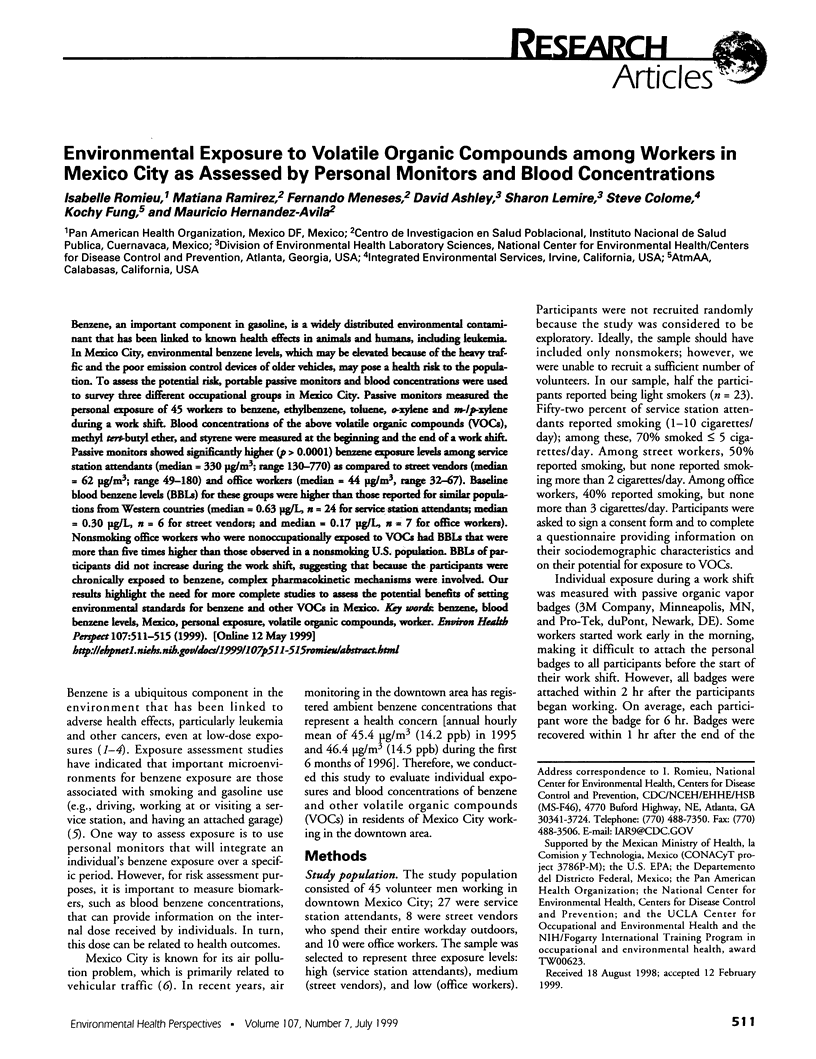
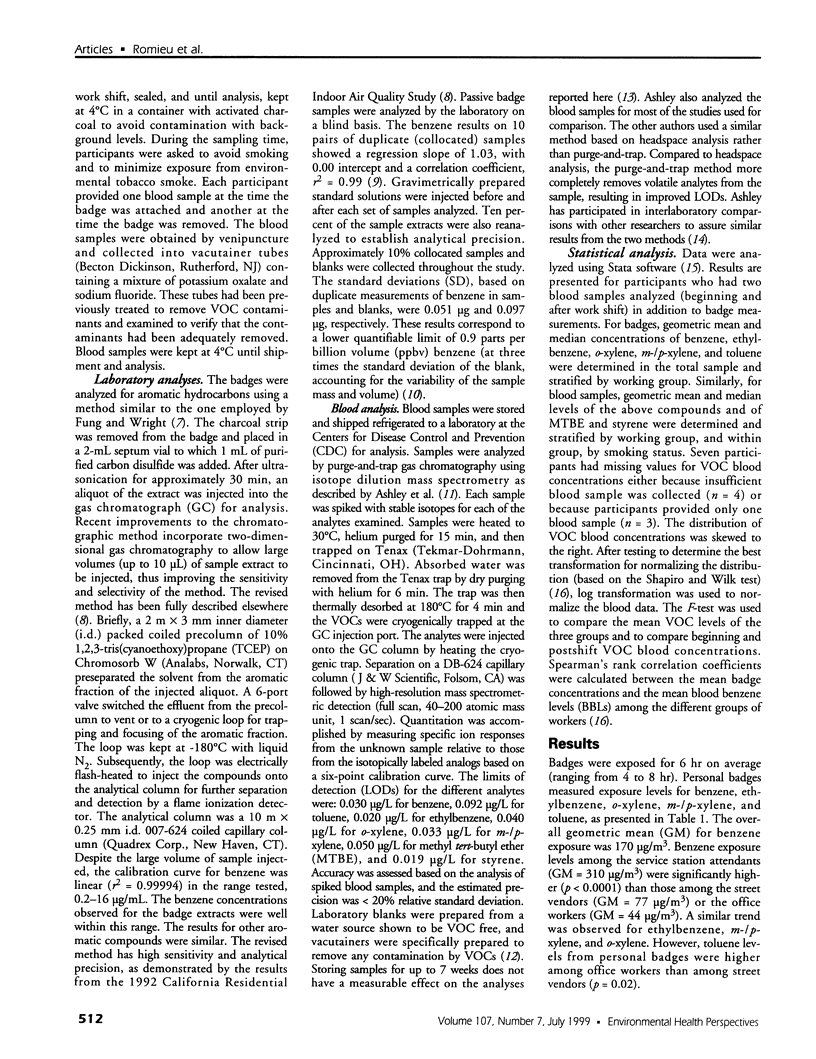
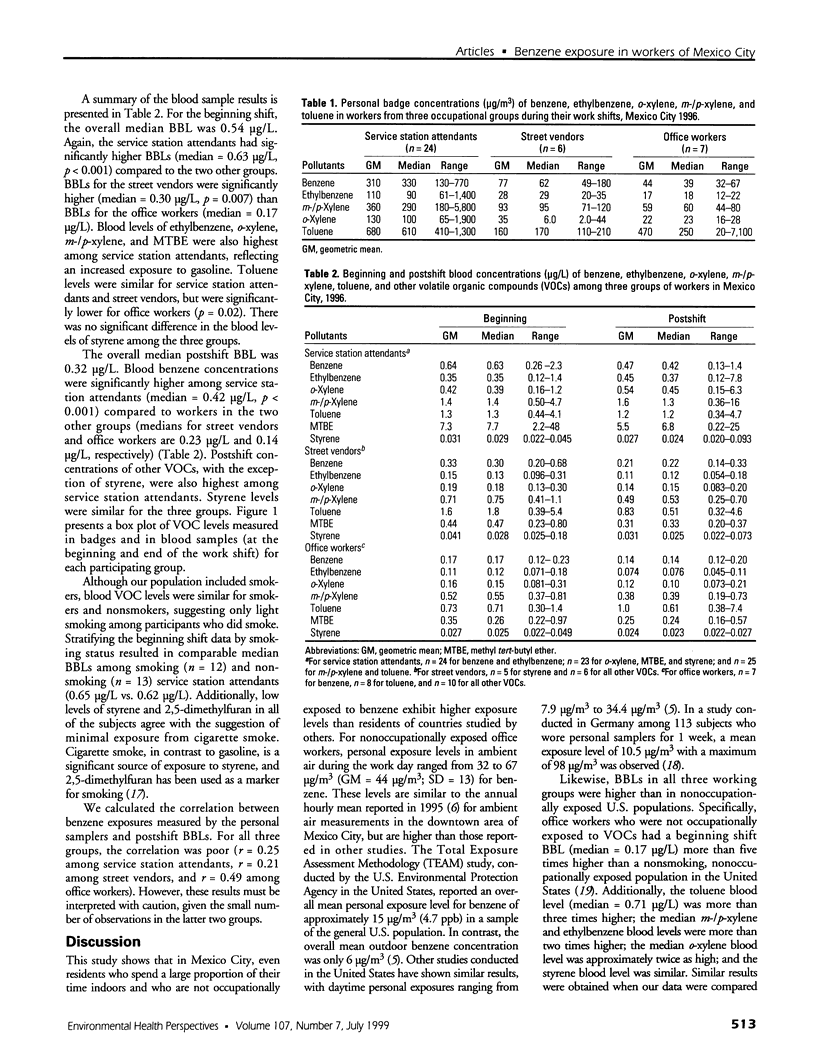
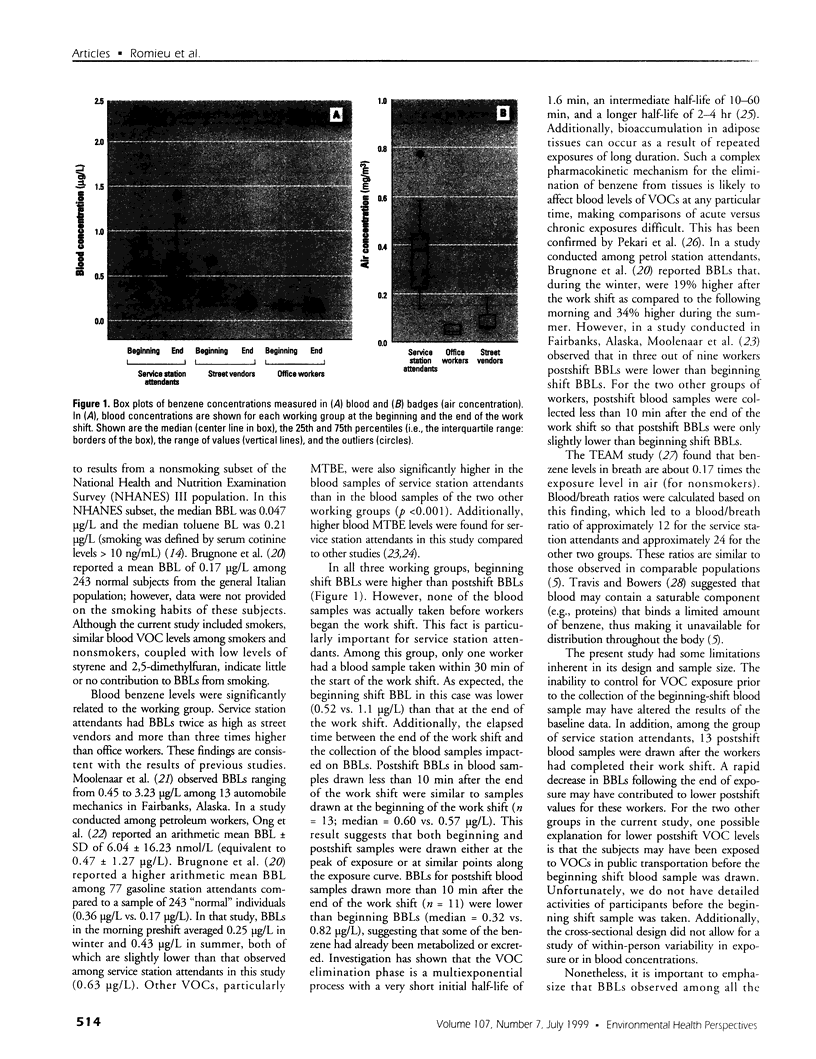
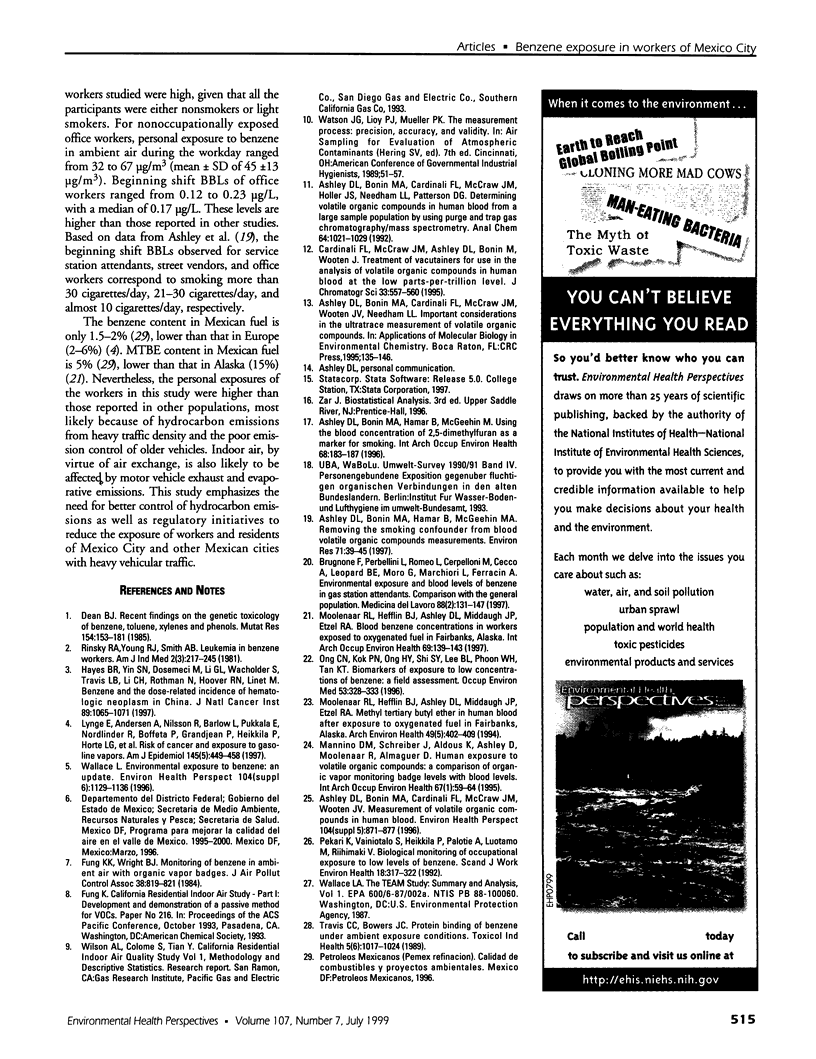
Images in this article
Selected References
These references are in PubMed. This may not be the complete list of references from this article.
- Ashley D. L., Bonin M. A., Cardinali F. L., McCraw J. M., Holler J. S., Needham L. L., Patterson D. G., Jr Determining volatile organic compounds in human blood from a large sample population by using purge and trap gas chromatography/mass spectrometry. Anal Chem. 1992 May 1;64(9):1021–1029. doi: 10.1021/ac00033a011. [DOI] [PubMed] [Google Scholar]
- Ashley D. L., Bonin M. A., Cardinali F. L., McCraw J. M., Wooten J. V. Measurement of volatile organic compounds in human blood. Environ Health Perspect. 1996 Oct;104 (Suppl 5):871–877. doi: 10.1289/ehp.96104s5871. [DOI] [PMC free article] [PubMed] [Google Scholar]
- Ashley D. L., Bonin M. A., Hamar B., McGeehin M. A. Removing the smoking confounder from blood volatile organic compounds measurements. Environ Res. 1995 Oct;71(1):39–45. doi: 10.1006/enrs.1995.1065. [DOI] [PubMed] [Google Scholar]
- Ashley D. L., Bonin M. A., Hamar B., McGeehin M. Using the blood concentration of 2,5-dimethylfuran as a marker for smoking. Int Arch Occup Environ Health. 1996;68(3):183–187. doi: 10.1007/BF00381629. [DOI] [PubMed] [Google Scholar]
- Brugnone F., Perbellini L., Romeo L., Cerpelloni M., Cecco A., Leopard Barra E., Moro G., Marchiori L., Ferracin A. Esposizione ambientale e livelli ematici di benzene negli addetti agli impianti di distribuzione carburanti. Confronto con la popolazione generale. Med Lav. 1997 Mar-Apr;88(2):131–147. [PubMed] [Google Scholar]
- Cardinali F. L., McCraw J. M., Ashley D. L., Bonin M., Wooten J. Treatment of vacutainers for use in the analysis of volatile organic compounds in human blood at the low parts-per-trillion level. J Chromatogr Sci. 1995 Oct;33(10):557–560. doi: 10.1093/chromsci/33.10.557. [DOI] [PubMed] [Google Scholar]
- Dean B. J. Recent findings on the genetic toxicology of benzene, toluene, xylenes and phenols. Mutat Res. 1985 Nov;154(3):153–181. doi: 10.1016/0165-1110(85)90016-8. [DOI] [PubMed] [Google Scholar]
- Hayes R. B., Yin S. N., Dosemeci M., Li G. L., Wacholder S., Travis L. B., Li C. Y., Rothman N., Hoover R. N., Linet M. S. Benzene and the dose-related incidence of hematologic neoplasms in China. Chinese Academy of Preventive Medicine--National Cancer Institute Benzene Study Group. J Natl Cancer Inst. 1997 Jul 16;89(14):1065–1071. doi: 10.1093/jnci/89.14.1065. [DOI] [PubMed] [Google Scholar]
- Lynge E., Andersen A., Nilsson R., Barlow L., Pukkala E., Nordlinder R., Boffetta P., Grandjean P., Heikkilä P., Hörte L. G. Risk of cancer and exposure to gasoline vapors. Am J Epidemiol. 1997 Mar 1;145(5):449–458. doi: 10.1093/oxfordjournals.aje.a009127. [DOI] [PubMed] [Google Scholar]
- Mannino D. M., Schreiber J., Aldous K., Ashley D., Moolenaar R., Almaguer D. Human exposure to volatile organic compounds: a comparison of organic vapor monitoring badge levels with blood levels. Int Arch Occup Environ Health. 1995;67(1):59–64. doi: 10.1007/BF00383134. [DOI] [PubMed] [Google Scholar]
- Moolenaar R. L., Hefflin B. J., Ashley D. L., Middaugh J. P., Etzel R. A. Blood benzene concentrations in workers exposed to oxygenated fuel in Fairbanks, Alaska. Int Arch Occup Environ Health. 1997;69(2):139–143. doi: 10.1007/s004200050128. [DOI] [PubMed] [Google Scholar]
- Moolenaar R. L., Hefflin B. J., Ashley D. L., Middaugh J. P., Etzel R. A. Methyl tertiary butyl ether in human blood after exposure to oxygenated fuel in Fairbanks, Alaska. Arch Environ Health. 1994 Sep-Oct;49(5):402–409. doi: 10.1080/00039896.1994.9954993. [DOI] [PubMed] [Google Scholar]
- Ong C. N., Kok P. W., Ong H. Y., Shi C. Y., Lee B. L., Phoon W. H., Tan K. T. Biomarkers of exposure to low concentrations of benzene: a field assessment. Occup Environ Med. 1996 May;53(5):328–333. doi: 10.1136/oem.53.5.328. [DOI] [PMC free article] [PubMed] [Google Scholar]
- Pekari K., Vainiotalo S., Heikkilä P., Palotie A., Luotamo M., Riihimäki V. Biological monitoring of occupational exposure to low levels of benzene. Scand J Work Environ Health. 1992 Oct;18(5):317–322. doi: 10.5271/sjweh.1570. [DOI] [PubMed] [Google Scholar]
- Rinsky R. A., Young R. J., Smith A. B. Leukemia in benzene workers. Am J Ind Med. 1981;2(3):217–245. doi: 10.1002/ajim.4700020305. [DOI] [PubMed] [Google Scholar]
- Travis C. C., Bowers J. C. Protein binding of benzene under ambient exposure conditions. Toxicol Ind Health. 1989 Dec;5(6):1017–1024. doi: 10.1177/074823378900500609. [DOI] [PubMed] [Google Scholar]
- Wallace L. Environmental exposure to benzene: an update. Environ Health Perspect. 1996 Dec;104 (Suppl 6):1129–1136. doi: 10.1289/ehp.961041129. [DOI] [PMC free article] [PubMed] [Google Scholar]



